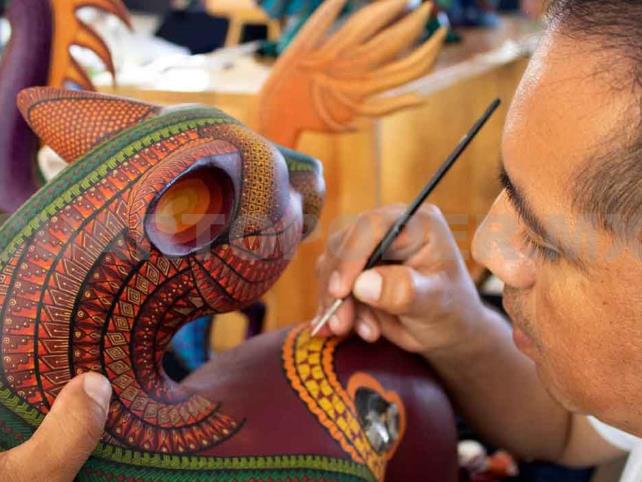The handicrafts, which are born from the wood carving in communities of the Central Valleys of
Oaxaca will be protected since the declaration of Geographical Indication was published in the
Official Gazette of the Federation, which is valid at the national and international level

Oaxaca de Juárez.— As of October 12th, the alebrijes, those fantastic beings that are born from the wood carving in communities of the Central Valleys of Oaxaca and that acquire life from the Zapotec motifs that the master craftsmen will decorate with a brush, will be protected throughout Mexico and internationally, since the declaration of Geographical Indication
(IG) was published in the Official Gazee of the Federation (DOF) .
Published by the Ministry of Economy and the Mexican Institute of Industrial Property, at the request of the Ministry of Economy of Oaxaca, with it the General Declaration of Protection of the
Geographical Indication “Alebrijes, Tonas, Nahuales y Tallas de Madera de los Valles Centrales de Oaxaca ”, which is valid nationally and internationally
According to the document, this protection is carried out at the request of the Oaxaca Ministry of Economy, headed by Juan Puablo Guzmán Cobián, and requested by means of a letter
received at the Mexican Institute of Industrial Property on August 28, 2020.

The process to achieve this international protection and which is included in the DOF publication indicates that the alebrijes, tonas, nahuales, and wood carvings of the Central Valleys of
Oaxaca is “a handicraft that consists of figures carved in wood of different genres and painted with a huge variety of colors and motifs ”.
The Geographical Indication protects these creations and, in accordance with the request, recognizes that these wooden figures can only be made at present, in these locations: San
Antonio Arrazola, San Martín Tilcajete, Unión Tejalápam, San Pedro Taviche and Oaxaca de Juárez.
According to the Government of Oaxaca, the application for Geographical Indication of Alebrijes, tonas, nahuales and wood carvings of the Central Valleys contemplates the protection of their history, materials, manufacturing process, obtaining wood, carving, drying, curing, painting, design, extraction sites, trade, and production and marketing criteria, among other factors.
Geographical Indications are international protections that differentiate and give value to the products that distinguish them since consumers can know the origin and prestige of a
product. Among the most famous and recognized are Roquefort”, French cheese,“ Café de Colombia ”for coffee,“ Chulucanas” ceramics from Peru,“ Thai silk ”from the Khorat plateau,
Thailand and“ Rioja ”wine from Spain.

International prestige
Last January, when EL UNIVERSAL announced that it was working on this protection for alebrijes, Juan Pablo Guzmán, state head of Economy, pointed out in an interview that
Geographical Indications give added value to these crafts, through certification and recognition, and It grants them protection since there can no longer be any more wooden figures that are made elsewhere or want to enter the country and sell themselves as such.

That is to say, with it the entry of any other figures that aunts as alebrije, tona or nahual is regulated and prohibited, because then it would proceed legally: “There would be lawsuits. A lot
happens with tequila, tequila arrives made in other places or countries and when it is detected at customs, a report is made to Mexico, it is verified that it is not really this drink, and fines
and sanctions are given. The product is also destroyed ”, he pointed out.
According to the IMPI, geographical indications are not the only protection mechanisms for Mexican products, there are also denominations of origin (PDO).

The official explained that both have the same value worldwide, but that while the GI has more recognition in the United States, the PDO has it in Europe.
“They do not compete or clash, the two seek to maintain the attributes of a product in the given region, but the only difference is that in a GI, not necessarily all the elements of the product originate from that place. For example, if the alebrije has a gold circle, the gold did not come out of that municipality, but the copal did, the carving itself, the teacher with his intellect and creativity yes, then it cannot be a Denomination of Origin, but it can be Indication Geographic ”.

“One is not better than another, they have the same weight, only that they are for different objects. The GI, for example, helps us to correct some errors from the past of previous designations of origin that are now a bit controversial, ”he said in reference to the dispute over mezcal

Source: eluniversal.com.mx, elfinanciero.com.mx





